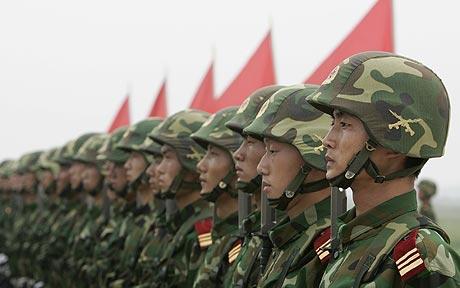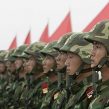
Kuayue-2009: Shifts in PLA Military Planning?
Publication: China Brief Volume: 9 Issue: 10
By:

According to official Chinese media reports, the People’s Liberation Army (PLA) will hold a massive two-month long military drill that will involve 50,000 troops from four divisions across four of China’s seven military commands in the second half of 2009. Citing a source from the PLA Headquarters of General Staff, which undertakes staff and operational functions for the PLA and implements military modernization plans, the drill, codenamed Kuayue-2009 (Stride-2009), is unprecedented in PLA military exercise history because it comprises four divisions from the Shenyang, Lanzhou, Jinan and Guangzhou Military Area Command. These exercises will reportedly include Air Force and Army Aviation units that military analysts say demonstrate a move toward bringing the PLA’s growing assets under a “common operational structure” to undertake “integrated joint warfare” (China Daily, May 5; China Review News, May 8; Defense News, May 11).
The official Xinhua News Agency on May 5 reported that the PLA has already started preparations for the exercise. According to the report, the drill is designed to assess the PLA’s capabilities in six major areas: 1) command and decision-making, 2) joint operations of land and air troops, 3) operations in complicated electro-magnetic conditions, 4) paratrooper assault operations, 5) simulated battles, and 6) comprehensive exercises by specialist units (China Daily, May 5; Global Times, May 5). Although the number of troops mobilized is not substantially large in terms of the scale of previous exercises, the drill will mobilize “more than 60,000 vehicles and large weapons and equipments” over a terrain that will cover more than 50,000 kilometers, and that “the longest one-way journey for some units will be more than 2,400 kilometers,” which will be a significant feat for the PLA’s “overall capabilities of operations under informationalized conditions” (Xinhua News Agency, May 5).
Chen Hu, chief-executive editor of the World Military Affairs Magazine, pointed out several notable characteristics of the Kuayue military exercise, like its organization and how it will likely be simultaneously executed from multiple locations, which sets it apart from previous military exercises. Chen pointed out that since the exercise has been termed a “series” of “base training exercises,” the use of “bases” likely refers to the PLA’s joint tactical training bases. In recent years the PLA has been developing training bases in each military command area to better simulate actual battlefield terrains, such as the Sanjie Joint Tactical Training Base under the Nanjing Military Area Command, the Queshan Tactical Training Base located under the Jinan Military Area Command, and the Zhurihe Joint Tactical Training Base under the Beijing Military Area Command. Moreover, since the capacity of one training base is not likely to be able to accommodate four fully equipped divisions, the exercise will probably be launched simultaneously from different bases (China Review News, May 8). According to a Western analyst cited by U.S.-based Defense News: “The PLA is moving away from ‘a combination of sequential or single arm or service operations … They are exercising this way and are doing it across regional and service boundaries’” (Defense News, May 11).
A professor at the PLA National Defense University, which is under the leadership of the PLA Central Committee, told the Global Times—an offshoot of People’s Daily—that the joint exercise is intended to help evaluate the PLA’s military delivery and logistics capabilities, as well as joint command and decision-making. Professor Li Daguang said that, “The PLA will practice the drill under almost real war conditions,” which means that it will most likely be a live-fire exercise. “Though China transported over 130,000 troops to the earthquake-hit region last year for relief work, troops were not armed with military equipment,” in Kuayue-2009 they “will maneuver 50,000 armed troops 50,000 kilometers in this drill” Li added (Global Times [Chinese], May 8).
According to an interview with Major General Luo Yuang, who serves as a political advisor and researcher at the PLA Academy of Military Science (PLAAMS), a research institute under the direct leadership of the Central Military Commission (CMC), “China’s positive defense policy is not makeshift, but a long-term policy based on traditional Chinese culture, the basic national situation and the social system” (Global Times, May 8).
In an interview with China Review News, Liang Yongchun, a military correspondent for China National Radio, noted that the PLA has made a leap in progress in terms of long-range training exercises in recent years. The first PLA military exercise involving long-range maneuvers was carried out in September 2006 by 3,400 troops from a mechanized infantry unit under the Shenyang Military Area Command and a division under the Beijing Military Area Command, which was held in the grasslands of north China’s Inner Mongolia Autonomous Region. The second long-range military maneuvers took place in August 2007 with the PLA mobilizing 1,600 troops to participate in the Shanghai Cooperation Organization’s "Peace Mission-2007," which was held in Russia. The PLA’s third long-range military maneuver, Sharpening-2008, took place in August 2008, which involved mobilizing mechanized infantry units from the Jinan Military Area Command more than 1,400 km to the Zhurihe Joint Tactical Training Base (see “PLA’s ‘New Leap Forward in Information-Centric Command,” China Brief, September 22, 2008).
A news report from Taiwan-based China Times described the absence of the Nanjing Military Area Command in the Kuayue-2009 exercise, which may be a possible sign of Beijing’s ‘good-will’ toward Taiwan, and may also be related to the current thaw in cross-Strait relations. The failure of the Nanjing Military Area Command to participate in the Kuayue-2009 exericse is notable because it oversees the “Taiwan area.” Chang Liang-ren, deputy minister of national defense of Taiwan, however, stated while responding to questions from ruling and opposition party members at a legislative hearing about the military exercise that it is still “premature” to draw such a conclusion and the question whether the exclusion of the Nanjing Military Area Command in the Kuayue-2009 exercise represents anything significant is being monitored and remains to be seen (China Times [Taiwan], May 7; Radio Taiwan International, May 7).





